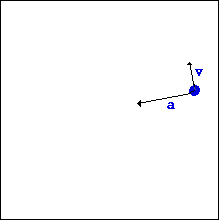| Uniform Circular
Motion Uniform circular motion can
be described as the motion of an object in a circle at a constant speed.
As an object moves in a circle, it is constantly changing its direction.
In all instances,
the object is moving tangent to the circle. Since the direction of the
velocity vector is the same as the direction of the object's motion, the
velocity vector is directed tangent to the circle as well. The animation
below depicts this by means of a vector arrow.

An object moving in a circle is accelerating.
Accelerating objects are objects which are changing their velocity -
either the speed (i.e., magnitude of the velocity vector) or the
direction. An object undergoing uniform circular motion is moving with
constant speed; nonetheless, it is accelerating due to its change in
direction. The direction of the acceleration is inwards. The animation
at the right depicts this by means of a vector arrow.
The final motion characteristic for an object
undergoing uniform circular motion is the net force. The net force
acting upon such an object is directed towards the center of the circle;
it is said to be an inward or centripetal
force. Without such an inward force, an object would continue in a
straight line, never deviating its direction. Yet, with the inward net
force directed perpendicular to the velocity vector, the object is
always changing its direction and undergoing an inward acceleration.
|